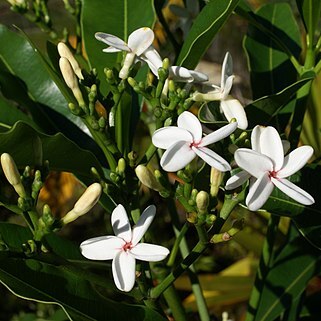Perennial shrubs or trees, evergreen; latex white. Stems without spines. Leaves petiolate, opposite or 3-or 4-whorled; lamina entire, chartaceous to coriaceous, glabrous; colleters absent. Inflorescences axillary, cymose, pedunculate. Flowers scented, sessile to pedicellate. Calyx without colleters. Corolla salverform; tube cylindrical, constricted at throat above stamens, glabrous, lacking scales; lobes dextrorse in bud. Corolline corona absent. Stamens included, inserted below mouth of corolla, not adherent to style-head; anthers oblong with acute tips. Disc absent. Style-head shortly cylindrical, bifid, with basal row of hairs. Fruit drupaceous, apocarpous or rarely syncarpous, cylindrical, ovoid or ellipsoidal, often angled. Seeds 2–6, compressed, elliptical or circular, narrowly winged, ecomose.
Trees with latex. Branches stout. Leaves in whorls of 3-5, rarely opposite; lateral veins numerous, subparallel, almost at a right angle to midvein. Cymes subterminal, pedunculate. Calyx deeply divided, usually without glands. Corolla salverform; tube slightly dilated above middle, to 1 cm, throat without scales; lobes overlapping to right. Stamens inserted in widening of corolla tube; anthers free from pistil head, narrowly oblong, rounded at base; disc absent. Ovaries 2, free or basally connate; ovules 2-6, biseriate on each side of a prominent placenta. Style filiform; pistil head shortly 2-cleft at apex. Drupes 1 or 2, smooth; endocarp thick, hard. Seeds 2-4 per locule, flat, not comose; endosperm none; cotyledons large, flat.

